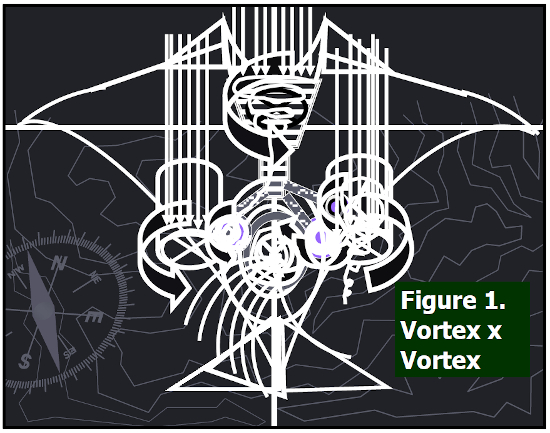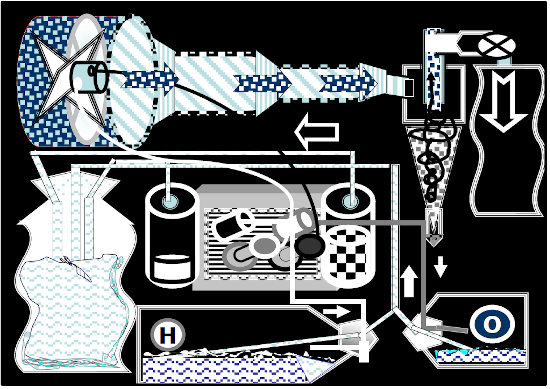Bio-Mimicry Studies of Aquatic Species and the Development of Solar Hydrogen Electric Autonomous Under Water Vehicles and Autonomous Airborne Vehicles (sHe-UAVs and sHe-AAVs)
Carl J. Lange1, BSME, MSME, PE, CPEI; Khan Sakeeb2, BS; Zarin Anika2; Estuardo Rodas3; Daniel Grey4; Kelin Chen5; Horace E. Walcott3, DVM, MSPH, MSc
Abstract
We have developed an unmanned solar hydrogen electric (UAV or drone) air sampling air ship and a drone solar hydrogen electric water sampling boat. The air craft was designed from data derived from the fluid dynamics of the manta ray (Manta birostris) and bio-mimicry studies of cartilaginous and teleostean fish. The aircraft has a wingspan of 6 m and a head to tail length of 4 m. It utilizes Mylar balloons with a total volume of 6.2 m3 and has a lift capacity of 30 kg (Dragonfly Innovations Inc., Saskatoon, SK, Canada). The body mass of the craft is 30 kg. The ventral surface of the craft is covered with bubble wrap and the dorsal surface with nylon (Goodwind’ Kites, Mount Vernon, WA, USA). The internal framework or skeleton consist of carbon fiber tubes with an outer diameter of 6.25x10-2 m diameter (Goodwind’ kites). A 0.3x1.858 m strip of ultra-thin solar panel with a capacity of 1.2 amperes and 15.4 V is one source of energy. Other sources of energy are a wind hydrogen electric reactor, a solar hydrogen electric reactor, and a rechargeable battery. The minimal kinetic energy output of the aircraft is 6.25x10-3 J.
Introduction
Autonomous under water vehicles (AUVs) powered by conventional batteries and solar energy have been developed for a variety of oceanographic uses.1,18 Other drone vehicles (AAVs), drone aircrafts powered by batteries and solar energy, have also been developed for military and civilian applications.3,14 Clark has conducted extensive fluid dynamic studies on models patterned after the manta ray (Manta birostris), with a major objective of applying the data derived from the studies to develop a plane with aerodynamically improved wings.4 Brower used computer tomography scans of manta rays to develop and test actuators capable of simulating the motion of the pectoral fin of the manta.2 In the area of application, bordered by AUVs and AAVs, is a sparsely explored locus in which solar hydrogen electrical energy and wind hydrogen electrical energy can be used to power drone vehicles used in zoo and wildlife medicine, including aquatic veterinary medicine and ecological medicine. We have developed and continue to develop solar hydrogen electric (sHe-) drones. One sHe- drone is a 1 m water-sampling boat and the other is an air ship with a wing span of 6 m and head-to-tail length of 4 m (Figure 1).3 Regular balloons and aircraft are not effective in monitoring air samples in a city or some war zones, such as the current Gulf region states. The use of a scuba diver or technician in an inflatable for monitoring ponds, lakes, and gigantic aquarium tanks is not economical. The drone water sampling boat and the drone airship were designed to fill the utility gap due to limitations of regular aircraft and boats.
Figure 1

The drone aircraft. The craft uses a series of vortices for its motion, air sampling, and energy conversion. The air sampling unit mimics the architecture of an avian or mammalian respiratory system.
Structure
The drone boat has a flat-bottom hull made of aluminum and a roof covered by six 3 V solar panels with a total current output of 0.6 amperes. Bolted down in the center of the hull is a robotic winch, which is attached by nylon cable and electrical cable to a probe at the bottom of the boat.2 A propeller with a shaft and rudder are attached to the stern of the boat. Three bottles containing hydrogen, oxygen, and water are connected by a series of tubes to a proton exchange membrane (PEM). Electrical leads connect the PEM to the solar panels and the motor of the winch and motor of the propeller. The bottles of water and gas, along with the PEM and solar panels, are components of the solar hydrogen reactor.9 Two 7.2 V, 1.9 ampere nickel-cadmium batteries are used as a back-up energy supply (Tower Hobbies, Champaign, IL).
The drone air ship is a much more complex machine (made at Brooklyn Technical High School, patent pending). Its shape mimics that of a manta ray (Figure 1).12,13 It has two 15.4 V, 1.2 ampere solar panels on the dorsal surface (www.powerfilmsolar.com). At the center is a 38 cm, triple-blade propeller. On the ventral and distal surfaces of each wing are 30 cm diameter propellers with motors. An air sampling unit consisting of three high-efficiency tangential inlet, axial-outlet discharge (HETAD) micro-cyclone precipitators, extends from the center of the craft to the anterior (made at Brooklyn Technical High School, patent pending) (Figure 2). The anterior of the craft is funnel shaped and the inlet is closed during flight by a robotic window. Two one liter sample bags are attached to the gas outlets of the cyclone precipitators. Immediately posterior to the robotic window is a wind turbine, which is attached to an auxiliary hydrogen reactor (made at Brooklyn Technical High School, patent pending). A major solar hydrogen electrical reactor is located in the mid-ventral area of the craft. Data from image analysis studies and fluid dynamics investigation, including buoyancy and pressure studies, were used in the construction of the craft.1,6-8,16
Figure 2

Air sampling unit and auxiliary solar hydrogen reactor. The wind energy rotates the turbine, which converts mechanical energy to electrical energy. The electrical energy splits the water in the reservoir into hydrogen and oxygen in the proton exchange membrane. The gases are conducted by tubes to the respective gas bags, where they are collected under negative pressure. The air increases in velocity as it moves through the ducts of decreasing diameter. The air then enters the cyclone precipitator where particulates are separated out and gases collected in the gas sample bags. Once the bags are filled, a valve at the entrance of the bag closes it and the air leaves through the exit duct of the cyclone precipitator.
Function
By means of a remote control panel, the boat can be auto-piloted. The submersible probe can be lowered to differing depths and water samples collected by gravity into four test tubes in the probe.9 The helium balloons enable the aircraft to have a vertical ascent (Figure 1). The propellers at the wings are used for vertical and horizontal motion. They simulate the propulsive energy of the wings of a manta ray. Vertical descent is accomplished by ballast and the propeller in the center of the craft. Remotely controlled valves allow air flow into the sampling bags and the cyclone precipitators.16,17
Discussion
Extensive fluid dynamic tests will be conducted on both crafts to improve kinematics and durability. The aircraft is currently undergoing a second phase of re-engineering in terms of design and development. In addition, submersible probes with larger sampling capacity will be developed for the drone boat. One question we plan to answer by experimentation is: how can developmental studies of sting rays yield insights into batoid wings for aircraft? 5,10,12,13,17,19
Conclusion
The drone aircraft utilizes hydrogen and oxygen derived from the photoelectrolysis of water as fuel and has capabilities for collecting three ranges of particle sizes from the air and gaseous samples from the atmosphere. The craft uses a series of vortices for its locomotion, energy conversion, and sample collection.6,11 The drone water sampling boat is capable of collecting four water samples and four different depths or four different regions in a body of water.9
Acknowledgments
We are most grateful to the Brooklyn Technical High School Alumni Research Foundation, who funded our project. Technical support was provided by Dr. William Stopskof and Dr. Andrea Goodnight. Without the wizardry of the BHTS Robotic Team, the crafts may not have had full lives. Special thanks to Boris Yuditskiy, Daniel Simkin, David Chen, and Galisa Allison. Last but not least, we thank Mr. Gordon Williams, BTHS Robotics instructor.
Literature Cited
1. Bliss T, Bart-Smith H, Iwasaki T. A biomimetic approach to efficient underwater propulsion. Industrial Sensing and Measurement SPIE. http//spie.org/x8743.xmi. 2008. (VIN editor: link was not accessible as of 1/13/2021.)
2. Brower TPL. Design of a Manta Ray Inspired Underwater Propulsive Mechanism for Long-Range, Low-Power Operation [master’s thesis]. North Grafton, MA: Tufts University; 2006.
3. Chen K, Grey D. The development and testing of a remote controlled solar hydrogen electric submarine. Annual Student Research Symposium of the National Consortium of Specialized Secondary Schools for Mathematics, Sciences, and Technology (MCSSSMST). Villanova, PA: 2005.
4. Clark RP, Smits AJ. Visualizations of the unsteady wake of a manta ray model. 44th AIAA Aerospace Sciences Meeting and Exhibit; Reno, NV: 2006.
5. Dean MN, Bizzarro JJ, Summers AP. The evolution of cranial design, diet, and feeding mechanisms in batoid fishes. Intgr Comp Biol Biology. 47:70–81.
6. Hesketh HE. Particle Collection. In: Fine Particles in Gaseous Media. 2nd ed. Chelsea, MI: Lewis Publishers, Inc.; 1980:109–155.
7. Kambe T. Fundamental Equations of Ideal Fluids. In: Elementary Fluid Mechanics. London, UK: World Scientific; 2007:31–34
8. Kambe T. Turbulence. In: Elementary Fluid Mechanics. London, UK: World Scientific; 2007:239–262.
9. Lange C, Chen K, Grey D, Walcott HE. The Development of a Drone Solar Hydrogen Electric Water Sampling Boat. US Patent Office, Provisional Patent. 2007.
10. Miyake T, McEachran JD, Walton PJ, Hall BK. Development and morphology of rostral cartilages in batoid fishes (Chondrichthyes; Batoidea), with comments on homology within vertebrates. Bio J Linnean Soc. 1992;46(3):259–298.
11. Noll E. Design of air pollution control devices. In: Fundamentals of Air Quality Systems. Annapolis, MD: American Academy of Environmental Engineers; 1999:126–161.
12. Rosenberger LJ, Westneat MW. Functional morphology of undulatory pectoral fin locomotion in the stingray Taeniura lymma (Chondrichthyes: Dasyatidae). J Exp Biol. 1999;202:3523–3539.
13. Schaefer JT, Summers AP. Batoid wing skeletal structure: novel morphologies, mechanical implications, and phylogenetic patterns. J Morphology. 2005;264:298–313.
14. Skyray 48 takes flight. In: ScienceDaily. www.sciencedaily.con releases/2007/09/070917471/html. Accessed Sept 20, 2007. (VIN editor: link was not accessible as of 1/13/2021.)
15. Walker JA, Westneat MW. Kinematics, dynamics, and energetics of rowing and flapping propulsion in fishes. Intgr Comp Biol Biology. 2002;42:1032–1043.
16. Webb P. Metabolism and energy. In: Hydrodynamics and Energetics of Fish Propulsion. Ottawa, ON: Department of the Environment, Fisheries, and Marine Science; Canada Bulletin 1975;190:109–119.
17. Wilga WAD, Lauder G. Biomechanics of locomotion in sharks, rays, and chimeras. In: Biology of Sharks and Their Relatives. Boca Raton, FL: CRC Press; 2004:139–164.
18. Whitman EC. Unmanned Underwater Vehicles: Beneath the Wave of the Future. www.navy.mil/navydata/cno/n87/usw/issue_15/wave.html: Accessed 2008. (VIN editor: link was not accessible as of 1/13/2021.)
19. Yong-hua Z, Shi-wu Z, Jie Y, Low KH. Morphologic optimal design of bionic undulating fin based on computational fluid dynamics. In: Mechatronics and Automation 2007. ICMA. 2007:491–496.